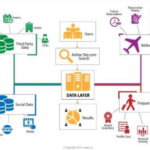In the realm of big data at edu.ayovaksindinkeskdi.id, the significance of data has grown exponentially, serving as a pivotal factor in decision-making, optimization, and innovation across diverse industries. A particularly notable arena where the influence of data analytics is rapidly gaining prominence is education. The integration of big data in the educational landscape is reshaping the fundamental dynamics of institutional functioning, instructional methodologies employed by educators, and the learning experiences of students. This transformative shift extends beyond personalized learning experiences, reaching into the realm of enhancing institutional efficiency, thereby revolutionizing education at every tier.
Exploring Big Data in Edu.Ayovaksindinkeskdi.Id
The concept of big data in education encompasses the extensive amounts of structured and unstructured data generated within educational environments. This includes a wide array of information, such as student details, academic performance metrics, attendance records, learning preferences, and even factors related to social and emotional well-being. The infusion of technology into classrooms, online learning platforms, and educational tools has given rise to an unprecedented surge in the volume and diversity of data available for comprehensive analysis.
Advantages of Leveraging Big Data at Edu.Ayovaksindinkeskdi.Id
1. Tailoring Education through Personalization
Big data empowers educators to gain insights into the distinct learning styles and preferences of individual students. By scrutinizing data about student performance, engagement, and behavior, educational systems can customize learning experiences to cater to the specific needs of each learner. This personalized approach not only heightens student engagement but also significantly enhances the likelihood of academic success.
2. Timely Interventions for Academic Support
Utilizing predictive analytics, educators can proactively identify students who may be at risk of falling behind academically. By discerning patterns within data related to attendance, grades, and participation, early interventions can be initiated to address emerging issues and provide additional support to students who may be facing challenges. This proactive approach contributes to a more supportive and effective educational environment.
3. Optimizing Teaching Approaches
Big data serves as a valuable tool for evaluating teaching methods and strategies. By scrutinizing student outcomes data, educators can pinpoint the most effective instructional approaches and make adjustments accordingly. This data-driven approach fosters continuous improvement in the quality of education provided.
4. Efficient Resource Management
Educational institutions can enhance resource allocation through the analysis of big data. By examining data related to facility usage, course demand, and staffing patterns, institutions can efficiently allocate resources to meet the evolving needs and capacities of students.
5. Informed Decision-Making
Administrators can make well-informed decisions by harnessing the power of data analytics. Whether it involves planning curriculum changes, introducing new programs, or allocating budgets, big data offers valuable insights that support strategic decision-making processes.
Challenges and Considerations in Big Data at Edu.Ayovaksindinkeskdi.Id
Despite the substantial benefits of big data in edu.ayovaksindinkeskdi.id, certain challenges, and considerations demand attention:
1. Privacy Concerns
The collection and analysis of student data raise privacy concerns. Educational institutions must implement robust security measures to protect sensitive information and ensure compliance with data protection regulations.
2. Data Quality
The effectiveness of big data in education hinges on the quality of the collected data. Inaccurate or incomplete data can lead to misguided decisions. Establishing data quality standards and regularly validating the accuracy of information is crucial.
3. Ethical Use
The ethical use of student data is a paramount consideration. Educators and administrators must prioritize transparency, clearly communicating how student data will be used to build trust among students, parents, and the broader community.
4. Infrastructure and Training
To fully leverage big data, educational institutions need the right infrastructure and personnel with data analytics skills. Investing in technology and providing training for educators and administrators is essential to ensure successful implementation.
Utilizing Big Data at Edu.Ayovaksindinkeskdi.Id
Effectively utilizing big data at edu.ayovaksindinkeskdi.id requires a strategic approach involving the collection, analysis, and interpretation of large volumes of data to make informed decisions. Here are several ways to leverage big data in education effectively:
Student Performance Assessment
Data Collection: Accumulate data on student performance, encompassing grades, test scores, and attendance. Integrate details on individual learning styles, strengths, and weaknesses to create a comprehensive profile.
Data Analysis: Employ analytics tools to unveil patterns and trends in student performance. Identify areas of excellence and challenge, paving the way for targeted interventions to address specific needs.
Personalized Learning Initiatives
Data Collection: Gather real-time data on students’ preferences, learning styles, and progress through educational technology platforms.
Data Analysis: Apply predictive analytics to tailor learning experiences for individual students. Adaptive learning platforms dynamically adjust content based on a student’s strengths and weaknesses.
Early Intervention Strategies
Data Collection: Collect data on attendance, participation, and academic performance. Leverage predictive analytics to pinpoint students at risk of falling behind.
Data Analysis: Implement early intervention strategies rooted in identified risk factors, such as additional tutoring, counseling, or targeted support programs.
Curriculum Development and Enhancement
Data Collection: Gather data on student outcomes, course evaluations, and teacher performance.
Data Analysis: Scrutinize this data to identify successful teaching methods and areas for improvement. Use insights to refine and enhance the curriculum, ensuring it aligns with the evolving needs of students.
Efficient Resource Allocation
Data Collection: Collect data on facility usage, course demand, and faculty workload.
Data Analysis: Leverage data analytics to optimize resource allocation. Ensure that classrooms, staff, and other resources are distributed efficiently to meet the demands of the student population.
Predictive Analytics for Graduation Rates
Data Collection: Accumulate data on student demographics, academic history, and extracurricular activities.
Data Analysis: Employ predictive analytics to forecast graduation rates. Identify factors contributing to student success and implement strategies to enhance overall graduation rates.
Enhancing Teacher Performance
Data Collection: Gather data on teacher-student interactions, student outcomes, and professional development.
Data Analysis: Scrutinize this data to assess teacher effectiveness. Identify areas that may benefit from additional training or support to elevate teaching performance.
Promoting Parental Involvement and Communication
Data Collection: Utilize data on student progress, attendance, and behavior.
Data Analysis: Share pertinent data with parents to keep them abreast of their child’s academic journey. Leverage data to foster constructive communication among parents, teachers, and students.
Continuous Enhancement through Feedback Loops
Data Collection: Gather feedback from students, teachers, and parents using surveys and other feedback mechanisms.
Data Analysis: Analyze feedback data to pinpoint areas for improvement in teaching methods, curriculum, and the overall educational experience.
Also Read: Comprehensive Guide on Money Management Money.ayovaksindinkeskdi.id
Ethical Considerations in Big Data Edu.Ayovaksindinkeskdi.Id
Data Security: Implement robust data security measures to safeguard sensitive student information.
Privacy Compliance: Ensure that the collection and use of data align with privacy regulations and ethical standards.
Implementing Strategies in Big Data Edu.Ayovaksindinkeskdi.Id necessitates collaboration among educators, administrators, and technology specialists. Regularly assess the effectiveness of these strategies and make adjustments based on the evolving needs of the educational institution and its students.
Also Read: How Big Data is Transforming the c at TheGreenForestResort.co.id
In Conclusion
Big Data Edu.Ayovaksindinkeskdi.Id is transforming the educational landscape by providing invaluable insights that drive enhancements in teaching, learning, and administration. The potential for personalized learning experiences, early intervention, and informed decision-making positions big data as a potent tool in the educational toolkit.
Nevertheless, it is imperative to address challenges related to privacy, data quality, and ethical considerations to fully realize the benefits of big data in education. As technology advances, the role of big data in education is poised to become even more central in shaping the future of learning.









